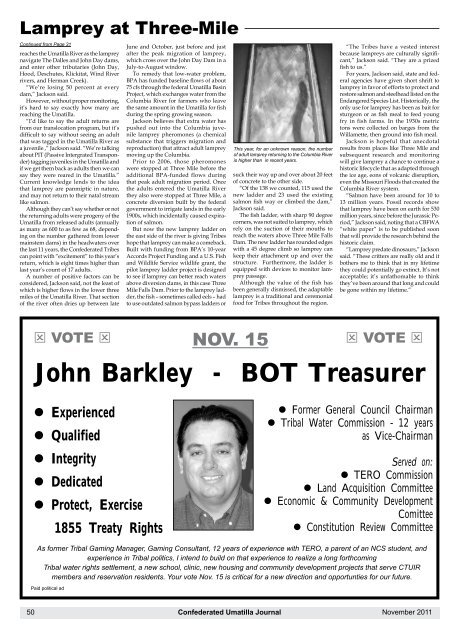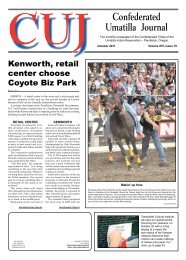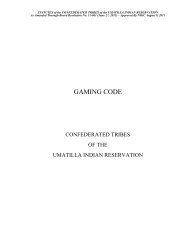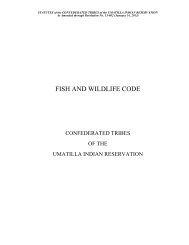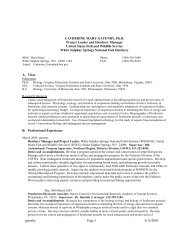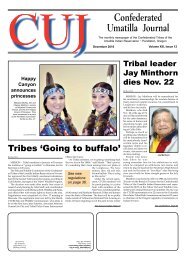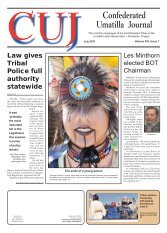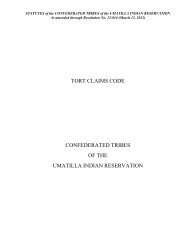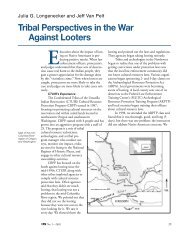Lamprey at Three-MileContinued from Page 31reaches <strong>the</strong> <strong>Umatilla</strong> River as <strong>the</strong> lampreynavigate The Dalles and John Day dams,and enter o<strong>the</strong>r tributaries (John Day,Hood, Deschutes, Klickitat, Wind Riverrivers, and Herman Creek).“We’re losing 50 percent at everydam,” Jackson said.However, without proper monitoring,it’s hard to say exactly how many arereaching <strong>the</strong> <strong>Umatilla</strong>.“I’d like to say <strong>the</strong> adult returns arefrom our translocation program, but it’sdifficult to say without seeing an adultthat was tagged in <strong>the</strong> <strong>Umatilla</strong> River asa juvenile ,” Jackson said. “We’re talkingabout PIT (Passive Intergrated Transponder)tagging juveniles in <strong>the</strong> <strong>Umatilla</strong> andif we get <strong>the</strong>m back as adults <strong>the</strong>n we cansay <strong>the</strong>y were reared in <strong>the</strong> <strong>Umatilla</strong>.”Current knowledge lends to <strong>the</strong> ideathat lamprey are panmiptic in nature,and may not return to <strong>the</strong>ir natal streamlike salmon.Although <strong>the</strong>y can’t say whe<strong>the</strong>r or not<strong>the</strong> returning adults were progeny <strong>of</strong> <strong>the</strong><strong>Umatilla</strong> from released adults (annuallyas many as 600 to as few as 68, dependingon <strong>the</strong> number ga<strong>the</strong>red from lowermainstem dams) in <strong>the</strong> headwaters over<strong>the</strong> last 11 years, <strong>the</strong> <strong>Confederated</strong> <strong>Tribes</strong>can point with “excitement” to this year’sreturn, which is eight times higher thanlast year’s count <strong>of</strong> 17 adults.A number <strong>of</strong> positive factors can beconsidered, Jackson said, not <strong>the</strong> least <strong>of</strong>which is higher flows in <strong>the</strong> lower threemiles <strong>of</strong> <strong>the</strong> <strong>Umatilla</strong> River. That section<strong>of</strong> <strong>the</strong> river <strong>of</strong>ten dries up between lateJune and October, just before and justafter <strong>the</strong> peak migration <strong>of</strong> lamprey,which cross over <strong>the</strong> John Day Dam in aJuly-to-August window.To remedy that low-water problem,BPA has funded baseline flows <strong>of</strong> about75 cfs through <strong>the</strong> federal <strong>Umatilla</strong> BasinProject, which exchanges water from <strong>the</strong>Columbia River for farmers who leave<strong>the</strong> same amount in <strong>the</strong> <strong>Umatilla</strong> for fishduring <strong>the</strong> spring growing season.Jackson believes that extra water haspushed out into <strong>the</strong> Columbia juvenilelamprey pheromones (a chemicalsubstance that triggers migration andreproduction) that attract adult lampreymoving up <strong>the</strong> Columbia.Prior to 2006, those pheromoneswere stopped at Three Mile before <strong>the</strong>additional BPA-funded flows duringthat peak adult migration period. Once<strong>the</strong> adults entered <strong>the</strong> <strong>Umatilla</strong> River<strong>the</strong>y also were stopped at Three Mile, aconcrete diversion built by <strong>the</strong> federalgovernment to irrigate lands in <strong>the</strong> early1900s, which incidentally caused expiration<strong>of</strong> salmon.But now <strong>the</strong> new lamprey ladder on<strong>the</strong> east side <strong>of</strong> <strong>the</strong> river is giving <strong>Tribes</strong>hope that lamprey can make a comeback.Built with funding from BPA’s 10-yearAccords Project Funding and a U.S. Fishand Wildlife Service wildlife grant, <strong>the</strong>pilot lamprey ladder project is designedto see if lamprey can better reach watersabove diversion dams, in this case ThreeMile Falls Dam. Prior to <strong>the</strong> lamprey ladder,<strong>the</strong> fish – sometimes called eels – hadto use outdated salmon bypass ladders orThis year, for an unknown reason, <strong>the</strong> number<strong>of</strong> adult lamprey returning to <strong>the</strong> Columbia Riveris higher than in recent years.suck <strong>the</strong>ir way up and over about 20 feet<strong>of</strong> concrete to <strong>the</strong> o<strong>the</strong>r side.“Of <strong>the</strong> 138 we counted, 115 used <strong>the</strong>new ladder and 23 used <strong>the</strong> existingsalmon fish way or climbed <strong>the</strong> dam,”Jackson said.The fish ladder, with sharp 90 degreecorners, was not suited to lamprey, whichrely on <strong>the</strong> suction <strong>of</strong> <strong>the</strong>ir mouths toreach <strong>the</strong> waters above Three Mile FallsDam. The new ladder has rounded edgeswith a 45 degree climb so lamprey cankeep <strong>the</strong>ir attachment up and over <strong>the</strong>structure. Fur<strong>the</strong>rmore, <strong>the</strong> ladder isequipped with devices to monitor lampreypassage.Although <strong>the</strong> value <strong>of</strong> <strong>the</strong> fish hasbeen generally dismissed, <strong>the</strong> adaptablelamprey is a traditional and ceremonialfood for <strong>Tribes</strong> throughout <strong>the</strong> region.“The <strong>Tribes</strong> have a vested interestbecause lampreys are culturally significant,”Jackson said. “They are a prizedfish to us.”For years, Jackson said, state and federalagencies have given short shrift tolamprey in favor <strong>of</strong> efforts to protect andrestore salmon and steelhead listed on <strong>the</strong>Endangered Species List. Historically, <strong>the</strong>only use for lamprey has been as bait forsturgeon or as fish meal to feed youngfry in fish farms. In <strong>the</strong> 1930s metrictons were collected on barges from <strong>the</strong>Willamette, <strong>the</strong>n ground into fish meal.Jackson is hopeful that anecdotalresults from places like Three Mile andsubsequent research and monitoringwill give lamprey a chance to continue ahistoric lifecycle that as adapted through<strong>the</strong> ice age, eons <strong>of</strong> volcanic disruption,even <strong>the</strong> Missouri Floods that created <strong>the</strong>Columbia River system.“Salmon have been around for 10 to13 million years. Fossil records showthat lamprey have been on earth for 530million years, since before <strong>the</strong> Jurassic Period,”Jackson said, noting that a CBFWA“white paper” is to be published soonthat will provide <strong>the</strong> research behind <strong>the</strong>historic claim.“Lamprey predate dinosaurs,” Jacksonsaid. “These critters are really old and itbo<strong>the</strong>rs me to think that in my lifetime<strong>the</strong>y could potentially go extinct. It’s notacceptable; it’s unfathomable to think<strong>the</strong>y’ve been around that long and couldbe gone within my lifetime.”Q vote Qnov. 15Q vote QJohn Barkley - BOT Treasurer• Experienced• Qualified• Integrity• Dedicated• Protect, Exercise1855 Treaty Rights• Former General Council Chairman• Tribal Water Commission - 12 yearsas Vice-ChairmanServed on:• TERO Commission• Land Acquisition Committee• Economic & Community DevelopmentComittee• Constitution Review CommitteeAs former Tribal Gaming Manager, Gaming Consultant, 12 years <strong>of</strong> experience with TERO, a parent <strong>of</strong> an NCS student, andexperience in Tribal politics, I intend to build on that experience to realize a long forthcomingTribal water rights settlement, a new school, clinic, new housing and community development projects that serve CTUIRmembers and reservation residents. Your vote Nov. 15 is critical for a new direction and opportunties for our future.Paid political ad50 <strong>Confederated</strong> <strong>Umatilla</strong> Journal<strong>November</strong> <strong>2011</strong>
Louie DickContinued from Page 2Program, Dick had a “special skill in communicatingtraditional values, such as <strong>Indian</strong> Law (Tamunwit)and First Foods to both <strong>Indian</strong> and non-<strong>Indian</strong> people.For <strong>Indian</strong>s, his actions strongly influenced <strong>the</strong> FirstFoods-based Department <strong>of</strong> Natural Resources missionstatements and program actions that are implementedtoday. For non-<strong>Indian</strong>s, his knack for telling stories andgiving examples greatly increased <strong>the</strong>ir understandingand respect <strong>of</strong> <strong>Indian</strong> ways and values.”John Barkley, who also reveres water, said Dick wasan inspiration.“He brought a significant traditional perspective thatreflected a reverence and humility to use and managewater with diligence and sensitivity for all creatures<strong>of</strong> life,” Barkley said. “I respected hiswords, compassion and devotion to thissacred resource and will truly miss him.”Dick was respected everywhere hewent and not just for his stance on water.Longtime friend Ron Pond said agood example <strong>of</strong> <strong>the</strong> people’s respectwas when Chief Raymond Burke, beforehe died, asked <strong>the</strong> community who <strong>the</strong>ythought should serve as a chief. Thenames <strong>of</strong> Dick and Pond were amongfour put up for consideration.Two o<strong>the</strong>rs sought chieftainships andDick and Pond took it no fur<strong>the</strong>r.Dick also was chosen to take a whipman’s role but <strong>the</strong> elder who recommendedhim, Winnie Burke, passedaway and out <strong>of</strong> respect Dick didn’t take<strong>the</strong> position.“That goes to show that people hadrespect for him and his family background– being from a warrior’s family,<strong>the</strong> Red Elks on his mo<strong>the</strong>r’s side and <strong>the</strong> Squeoch’sfamily on his fa<strong>the</strong>r’s side.”Marcus Luke knew Dick from <strong>the</strong> Longhouse andrespected his ways.“He always expressed traditional values at <strong>the</strong>Longhouse in our language, which is needed today.To some he was stern, but ones who had traditionalteachings understood.”People understood Dick’s vision for a sustainable,healthy world. He expressed it in many ways, not<strong>the</strong> least <strong>of</strong> which was in words that will live longafter his death:“Water is life. Without water <strong>the</strong>re is no life.”Editor’s Note: Louie Dick’s obituary appears on page 10.Above, Louie Dick was involved in sports as a youngster. At right, he participatedfor many years in <strong>the</strong> annual Happy Canyon Pageant at <strong>the</strong> Pendleton Round-Up.Oregon Water Quality standardsContinued from Page 17Legislature on <strong>the</strong> status <strong>of</strong> human healthtoxics rulemaking, including specific informationon <strong>the</strong> use <strong>of</strong> variances.EPA’s decision this week follows <strong>the</strong>recommendation <strong>of</strong> <strong>the</strong> Oregon EnvironmentalQuality Commission, whichadopted <strong>the</strong> new water quality standardsin August. The Oregon EQC sets policybased on recommendations from <strong>the</strong>Oregon (DEQ).At <strong>the</strong> urging <strong>of</strong> <strong>the</strong> <strong>Umatilla</strong> <strong>Tribes</strong>,Oregon DEQ arrived at <strong>the</strong> higher fishconsumption rate after an extensive review<strong>of</strong> relevant fish consumption studiesby a panel <strong>of</strong> health pr<strong>of</strong>essionals andthrough public workshops and commentperiods that spanned several years.McLarren praised <strong>the</strong> work <strong>of</strong> <strong>the</strong>Oregon DEQ and <strong>the</strong> <strong>Umatilla</strong> <strong>Tribes</strong>for “conducting a thoughtful public dialoguewith tribal governments, citizens,municipalities, industry and o<strong>the</strong>rs tounderstand <strong>the</strong> issues associated withincreasing <strong>the</strong> fish consumption rate usedin your water quality standards.”EPA’s approval is testament to years <strong>of</strong>collaborative work, Pedersen said.“EPA’s decision endorses <strong>the</strong> years <strong>of</strong>hard work by <strong>the</strong> state and <strong>the</strong> <strong>Umatilla</strong>Tribe,” Pedersen said. “The standardallows us to move forward as Oregondecides how best to reduce toxics in collaborationand in a thoughtful way toimprove water so fish are safe and <strong>the</strong>people who eat fish are safe.”Pedersen said that without <strong>the</strong> influence<strong>of</strong> <strong>the</strong> <strong>Umatilla</strong> <strong>Tribes</strong>, DEQ probablywould not have pushed as hard fornew human health criteria.“Without <strong>the</strong>ir leadership <strong>the</strong> taskwould have been a lot harder than itwas,” he said. “I don’t think we wouldhave pushed as hard without <strong>the</strong> tribalcomponent. Through collaboration, <strong>the</strong>tribes were instrumental in what weended up getting.”It was a long struggle arriving at <strong>the</strong>new Water Quality Standards.In August, <strong>the</strong> Oregon EQC approved<strong>the</strong> standards by a 4-1 margin, with ViceChair Ken Williamson saying <strong>the</strong> standards“provide greater protections forsensitive populations. As a society weneed to provide <strong>the</strong>se protections. We aremoving in <strong>the</strong> right direction.”The new rules put limits on 104 toxicpollutants (48 non-carcinogens and 56carcinogens) based on studies that havedocumented that certain populations,including Native Americans, eat morefish than <strong>the</strong> general population in <strong>the</strong>United States, and that toxics found infish from Oregon waterways cause cancer,and effect immune, reproductive andnervous systems.Prior to its efforts to develop <strong>the</strong>se newrevisions, DEQ developed and adoptedrules in 2004. DEQ based <strong>the</strong> criteria for<strong>the</strong> 2004 rules on EPA’s recommendedcriteria at <strong>the</strong> time, which used an assumed17.5 grams (that cracker-sizeportion) for <strong>the</strong> general population perday fish consumption rate.At <strong>the</strong> time (2004) that Oregon approvedthose standards, <strong>the</strong> <strong>Umatilla</strong><strong>Tribes</strong> expressed concerns to EPA that<strong>the</strong> standards were not protective enoughfor high fish consumers and did not meetEPA’s guidance that local data be used tomake decisions on criteria.In 2006, DEQ, EPA and <strong>the</strong> <strong>Umatilla</strong><strong>Tribes</strong> reached an agreement to worktoge<strong>the</strong>r collaboratively to revise <strong>the</strong> fishconsumption rate.In what would be a five-year process, DEQbegan re-evaluating its water quality standards,holding seven workshops around <strong>the</strong> state toshare information and discuss stakeholders’views about <strong>the</strong> fish consumption rate.DEQ convened workgroups thatlooked at public health, and <strong>the</strong> fiscalimpact and implementation <strong>of</strong> newrules. Workgroups included representativesfrom industry, local governments,non-government organizations, and localgroups meeting to develop <strong>the</strong> newcriteria with <strong>the</strong> intention <strong>of</strong> lowering <strong>the</strong>allowable amount <strong>of</strong> pollutants releasedto Oregon waters while, at <strong>the</strong> same time,considering variances and o<strong>the</strong>r actionsthat would provide affordable optionsto those that discharge those pollutants.Meanwhile, in 2009, while stakeholderswere meeting to hash out a new fishconsumption rate, Oregon DEQ and EPAwere sued for failing to meet federalClean Water Act deadlines.Because <strong>the</strong> rulemaking process wasnot complete - data, comments and inputwas not yet available - EPA had nottaken action. A federal court orderedEPA to take action on Oregon’s existingstandards.In June 2010, EPA disapproved those2004 standards because, as agreed uponin 2006, <strong>the</strong>y were not protective enough<strong>of</strong> Oregonians based on <strong>the</strong> amount <strong>of</strong>fish <strong>the</strong>y are known to consume.EPA’s disapproval caused <strong>the</strong> majority<strong>of</strong> <strong>the</strong> 2004 water quality criteria to nolonger be effective, leaving in place <strong>the</strong>previous criteria <strong>of</strong> 6.5 grams per day thatwas adopted in <strong>the</strong> late 1980s.The new adopted rules address EPA’sdisapproval <strong>of</strong> DEQ’s 2004 criteria andobviate <strong>the</strong> need for EPA to promulgatefederal rules for Oregon.Meanwhile, <strong>the</strong> Washington Department<strong>of</strong> Ecology has started a processintended to prevent sources <strong>of</strong> toxicchemicals that contaminate air, water,soil and human bodies.Toward that goal, according to a newsrelease from <strong>the</strong> Washington DOE, <strong>the</strong>state is asking for comments on a newlyreleased technical support document,which focuses on fish consumption inWashington and existing environmentaland human health information. The draftdocument is called “Fish ConsumptionRates Technical Support Document: AReview <strong>of</strong> Data and Information AboutFish Consumption in Washington.”Washington currently uses an existingfish consumption rate <strong>of</strong> 6.5 gramsper day (26 times lower than <strong>the</strong> newlyadopted Oregon rate) in its water qualitystandards.The draft document is available onDOE’s fish consumption web portal,which can be found at www.ecy.wa.gov/toxics/fish.html. The comment periodends Dec. 30, <strong>2011</strong>.For more details on Oregon’s newstandards, see DEQ’s “human healthrulemaking” web page at http://www.deq.state.or.us/wq/standards/humanhealthrule.htm<strong>November</strong> <strong>2011</strong><strong>Confederated</strong> <strong>Umatilla</strong> Journal51


